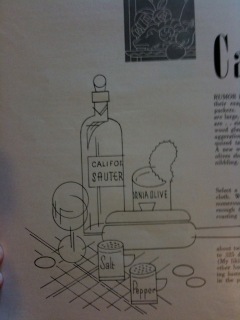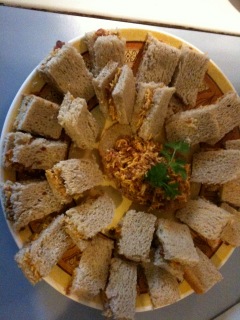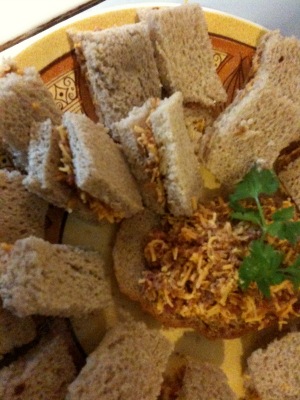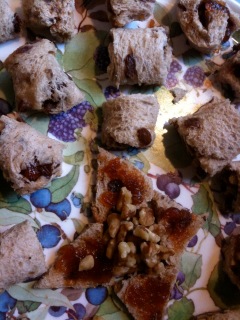Inspired by those cheerful and enterprising folks who re-create dishes of the long ago, amazing people like Ken Albala, I decided to also boldly go into kitchens of the past with a few trusty implements and oils. However, I am a little braver than your average culinary historian: I’m going into the most reviled era in food history–the revolutionary period from about 1910 to 1980 when so many of the packaged goods that are decried by food intelligentsia were created, celebrated, and beloved. Why do I want to cook and eat all the things that I have been told Julia Child saved us from? I’m doing it because I want to know–from experience–what the most popular flavors were in that vital era in American history, the textures and techniques that made the Betty Crocker Picture Cookbook and the Good Housekeeping Cookbook two of the best selling books of their time. If it makes sense to listen to the music of an era, read its novels and look at its paintings, doesn’t it make sense to taste its food? I’m rolling my fork up in a napkin and taking an open-minded approach, remembering always–I’m here to taste, not to judge.
Ever Evasive Evans Brown
Today I am looking at another Helen Evans Brown cookbook and again find her refusing to eat.
In an earlier posting Brown refused to tell readers about tamale pies. In California Cooks, a collection of articles she published in The Californian, she rejects persimmons, but in the most alluring way:
“At last I’v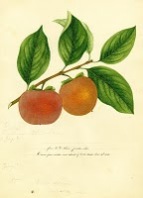 e come to them. They’re an autumnal rite with me. I watch them change their color, soften, reach that stage of transparency and utter ripeness when they are at their very best, I’m told.
e come to them. They’re an autumnal rite with me. I watch them change their color, soften, reach that stage of transparency and utter ripeness when they are at their very best, I’m told.
And then, when they’ve become of more than passing interest to the fruit flies, I throw them, ever so reluctantly, into the garbage can. But don’t listen to me. Listen to the gourmet who says they are best eaten directly from the skin, scooping out the flesh with a spoon.” Why does she tease us this way? Brown is introducing her readers to a new way of thinking about food, one that values knowledge about food that goes beyond “just” cooking or even just eating. Her oblique relationship with the persimmon introduces the personal, emotional mood into her food writing. She isn’t giving tips on fruit cookery, she’s giving insight into her own aesthetics.
Brown was one an early promoter of the idea of California cuisine, writing that “it won’t be long now” before California cuisine would be recognized as “the greatest cuisine in all the world.” The recipes in California Cooks emphasize ingredients grown in and associated with California.
“Almonds are High Style in the Culinary Circles of California,” she assures us.
 Brown provides recipes for curried almond toast, california chicken saute, and English almond-butter toffee, while also subtly letting us know that there is something going on out west. We aren’t part of it yet.
Brown provides recipes for curried almond toast, california chicken saute, and English almond-butter toffee, while also subtly letting us know that there is something going on out west. We aren’t part of it yet.
Brown provides recipes for curried almond toast, California chicken saute, and English almond-butter toffee, while also subtly letting us know that there is something going on out west. We aren’t part of it yet. Brown provides recipes for curried almond toast, california chicken saute, and English almond-butter toffee, while also subtly letting us know that there is something going on out west. We aren’t part of it yet. She writes of ranch life “free and easy–that’s the ranch life in California” that does not seem to involve rustling up anything more than dinner. Even that might be done by a movie star:
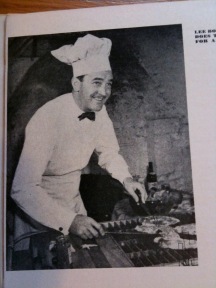 |
| Lee Bowman, Columbia Star, does the Barbecue Chores for a Patio Ranch Supper |
Despite her emphasis on pleasure and her advice to “play at” cooking in order to improve your skills, Brown also includes a section titled “Eat, Drink and be Slender.” It’s a section that fits perfectly with national stereotypes about Southern California prevalent in her era as well as our own. The stars have to stay slim, so they must have secrets to share with the rest of us… Brown promised that “you can enjoy your food and still trim yourself down to bathing suit size if you’ll eat things that are not too high in those insidious calories.”
Her prescriptions do not differ much from those of other diet advisors: “More about breakfast: Do have fruit, a piece of whole wheat toast without you know what, and an egg.” And for lunch the usual “salad or a vegetable plate, and either a glass of skimmed milk or some yami yogurt.” She also includes the peppy/recriminating advice that “losing weight is 90 per cent the desire to lose it.”
Posted in Uncategorized
Where’s the Tamale Pie?
This week’s book is Helen Evans Brown’s West Coast Cook Book, published in 1952. Brown was a close friend of James Beard and published widely in magazines. This book contains recipes that Brown thought were especially, though perhaps not uniquely, “West Coast,” including recipes from California, Oregon, and Washington.
She wrote about West Coast cooking as part of an improvisational, casual culture: “This is a book of West Coast cuisine–if anything as simple as our cookery can be called a cuisine.” The casual style is reflected in a chapter titled “Barbecuing and Charcoal Grilling.” Although Brown referred to great pit barbecue feasts in California’s history, she focused on the smaller scale: “When we speak of barbecuing, we usually mean charcoal grilling, and refer to individual or family-sized pieces.”
Brown includes an unusually large number of recipes identified as Chinese and Mexican throughout the regular sections of the book. Her introduction tells readers that of all the “foreign” foods cooked in California, “I have admitted only those that have been generally adopted or adapted by us,” assuming an Anglo-American audience. What she seems to mean is those Chinese and Mexican dishes that were most often enjoyed by readers like herself in restaurants. For example, her recipe for “Chinese Garlic Lobster, begins “Chow hung hai is what this is called, or so it sounds to me. It’s a favorite among habitues of the best Chinese restaurants.” Although she gives a recipe for making tortillas, she admits that “most of us bow our heads to progress and purchase the inferior machine-made jobs.”
As we might expect, there are lots of seafood recipes featuring abalone, crab, and salmon, foods that are special to this region. Brown also wrote a section about wine which marked her as a “gourmet”or taste leader and also as a booster of California’s wine industry. “The most important thing,” she argued “is that we have our own wines, and that they are worthy ones … Today there are many of us who, knowing the really fine wines that can be produced by California vintners, are well content to forget those of Europe. Forget, not compare them.” She wasn’t going to give up drinking French wine, just stop drinking Californian wines with France on her mind.
Something that sets this book apart from others of its era is a section dedicated to descriptions of local cheeses. While Americans ate cheese in this period, they do not seem to have thought about varieties of cheese very much or to have thought of themselves as a cheese-making nation. Brown wrote about Oregonian Tillamook, which is still well known, but also the much more obscure Sierra, made in Novato, California. She described Sierra as “small and round, weighing only 4 ounces, it is somewhat like a Neufchatel, somewhat like a Camembert.” Eating cheese at breakfast, Brown noted, “is a pleasant West Coast habit.”
For me, the most interesting recipe is the refusal to give a recipe.
Her entry for Tamale Pie, a popular dish in the first half of the Twentieth century, reads:
“Tamale pie is disowned by many Mexicans, though there are recipes for it in some of their cook books. There are, in fact, recipes for it in far too many cook books, so those who like it—and many apparently do—should have no trouble in learning how to make it.”
She refuses to give a recipe, and yet she mentions the dish all the same. What is happening here? Brown is establishing her credentials not only as someone who knows all about “authentic” Mexican food (even better than some Mexicans, she implies), but also as a taste-leader for Americans. For Brown, striving to improve what she saw as errors in American food culture, it was not enough to exclude tamale pie, she had to mock it, too.
The entry is inspiring in a way. What would a cookbook look like that only included foods the author did not like?
Posted in Uncategorized
Fulfillment of a Dream
Ever since I read the lists of “male” and “female” sandwiches in the 1942 Women’s Voluntary Services Cookbook by Marion Gregg, I have been wanting to make them and serve them at an event. My strange dream comes true today. I should probably explain, in this age of erotic cakes, that the sandwiches were designated male or female according to who was supposed to enjoy them. The gender stereotyping of taste is what we’re nibbling on here.
Here is the “male” sandwich that I chose from the list. The manly ingredients are: chopped bacon, shredded cheddar cheese, mayonnaise, and mustard spread on rye. The platter goes so beautifully with them I think.
The garnish was a problem, as I had forgotten to buy any parsley. I was lucky enough to find a sprig of cilantro in the fridge at the research center where I am working. It’s not historically accurate and I guess you could consider it stollen, but it works visually.
The mound of extra filling in the middle was my own amazing stroke-of-genius.
And now the female sandwiches: quince paste and chopped walnuts on raisin bread.
I like the platter for these ones, too.
I am serving them at an event at which I will be talking about the construction of the gourmet in American culture, a pretty academic topic. I’ll be arguing (not to spoil anything) that the character of the Gourmet was constructed as male and established in reaction to a female food culture that was dominant in cookbooks at the time, the 1940s. So it seemed like the right time to serve these, very un-Gourmet sandwiches. One important thing I have already learned from this experience is that you can buy pre-cooked, pre-crumbled bacon. Yay! I will also be serving a cheese plate (brie, blue, cheddar) and baguette for those who can’t get their heads or mouths around eating history. And I’ll be serving two California wines to compliment this clip, which I’ll be using in my presentation. Bon Apetit!
Posted in Uncategorized
Useful bonbons
 Today I read this beautiful sentiment: ““Pure candy is a useful food, when eaten at the proper time, at the close of a meal.” Useful for what, I did not learn, but I have my own ideas.
Today I read this beautiful sentiment: ““Pure candy is a useful food, when eaten at the proper time, at the close of a meal.” Useful for what, I did not learn, but I have my own ideas.
This quotation is from a 1941 book designed as a textbook for seventh, eighth and ninth grade cooking classes in Connecticut public schools. There followed recipes for chocolate fudge, peanut brittle, and popcorn balls.
The endorsement of sweets as “useful” in a healthy diet reminded me of a mystery that has long bothered me.
Ever since the 1940s it has been fashionable to rail against “scientific cookery” as the denial of all that is pleasurable about food. M.F.K. Fisher, America’s most famous food writer, warned, “to be passed by quickly with a shudder of recognition are cooking-school manuals.” Yet nowhere in my years of research into American cookbooks have I found one book that advocated the eating of just what was healthy and not what was flavorful.
The Connecticut Board of Education’s Outline of Cooking reaffirmed my sense that tasteless scientific cuisine was a straw man in the kitchen. This week’s featured book, The American Woman’s Cook Book, published first in 1939, is a triumphant melange of nutritional wisdom and pure deliciousness, 1940s style. Far from being bound by the dictates of health, the book bursts with sugar, cream, butter, and even wine.
It is important to remember and respect that the culinary aesthetic of this book is of a particular era, not our own. I think it is too easy for modern readers to mock the molded salads 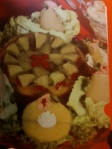 and sandwiches-disguised-as-cakes and to miss the fact that this food was fun for the people who made and ate it.
and sandwiches-disguised-as-cakes and to miss the fact that this food was fun for the people who made and ate it.
 Given free will and fully-stocked supermarkets, would Americans have bought the cookbooks and magazines that told them how to make these treats if they didn’t want to eat them? Would they have prepared them for company and for group events?
Given free will and fully-stocked supermarkets, would Americans have bought the cookbooks and magazines that told them how to make these treats if they didn’t want to eat them? Would they have prepared them for company and for group events?
The dominant culinary aesthetic of today (if there really is such a thing) does not emphasize display in the style captured in these photographs from the 1943 “Victory” edition of the American Woman’s Cook Book. We may think of food and fun as connected to each other, but our sense of both terms has changed over time.
The American Woman’s Cook Book was prepared by Ruth Berolzheimer, a prolific cookbook compiler of the 1940s and 1950s, as a revision of the Delineator Cook Book, a book put together by the editor of Delineator magazine with the help of the directors of the Department of Home Economics at Cornell University.
The book is “scientific” in that it provides basic instructions, tables of measurements, and basic temperature guides for cooking a wide variety of foods in many different ways. It also includes a guide to the different food groups as they were understood at the time, “What Food Materials do For the Body,” and “Where to find these building and protecting foods.”
Like M.F.K. Fisher (shudder though she might), the authors of the book encouraged thinking about nutrition over the course of the day, rather than packing all necessary elements into each meal: “the food for the entire day is the real measure of good nutrition.” In her wartime cookbook, How to Cook a Wolf, Fisher wrote, “Try this simple plan: balance the day, not the meal.” The American Woman’s Cook Book does include the kinds of sample menus that drove Fisher crazy, but for someone curious about nutrition, they could be very useful. And they conveyed the important message that to think about health was not to forgo pleasure.
The menus are also interesting to look at now as they give an idea of what was considered normal food. Picking randomly from the menus, I could start my day with
Breakfast: Stewed apricots, corn meal mush, buttered toast, coffee, and milk.
I might work for a while before stopping for Lunch: cheese fondue, vegetable salad, bread, and cereal pudding with dates.
And then at the end of the day, enjoy Dinner: Fish chowder with water wafers, grapefruit salad, graham bread and butter, and Queen of Puddings.
I can’t remember the last time I had two puddings in one day.
Although the menus above are very much in the accepted culinary mainstream of the Anglo-American middle class, the book also features a section on French cooking, where I found an “Economical Vegetable Soup” very similar to the one Fisher calls her “sludge … my streamlined answer to the pressing problem of how to exist the best possible way for the least amount of money” in the essay “How to Keep Alive.”
So, while the American Woman’s Cook Book does offer the unappetizing suggestion to keep in mind “the most satisfactory conditions of digestion and elimination” while planning my menu, it also reminds me to think of texture, appearance and flavor, teaches me how to choose and cook with wine, and offers me this final thought:
 |
| “Cheese with wafers, fruit and a mint julep promote good conversation in the late afternoon.” |
So why is it that revealing the science behind food overshadowed all the honey hermits, franconia potatoes, buttered fennel, and “luscious dinner” of pot roast with carrots and onions?
Posted in Uncategorized


